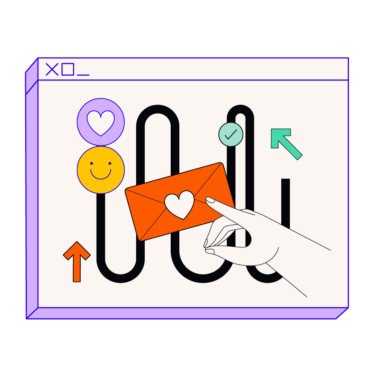At beginning of the COVID-19 pandemic, the US saw a significant increase in internet use.
In the first weeks of March 2020 alone, in-home data usage increased 18 percent. Video conferencing, streaming video, and online grocery/meal delivery services have become more essential. Many employees now work from home.
A good online user experience depends on a well-managed digital experience platform. Organizations with platforms that are difficult to navigate will turn away potential customers. An inefficient employee digital experience platform hinders work processes and lowers employee satisfaction and retention.
What is digital experience?
Digital experience is the digital interaction between the user and an organization. The user can be a customer, partner, or employee. When you buy something from Amazon or check health benefits online, you’re engaging in a digital experience.
Organizations use content to build relationships with the customer, but the content is only a small part of the experience. Digital experience is the entire process of that interaction, from first clicking on the web page to follow-up with customer service after a purchase.
What are the elements of a good digital experience?
The most important elements of a good digital experience, according to 80 percent of US consumers, are the following:
- Speed: how quickly the web page loads
- Convenience: how many digital channels (smartphone, computer, etc.) on which the organization can be accessed
- Hospitality: a human touch should be present throughout the digital experience and during support processes
- Knowledgeable assistance: well-trained customer service employees and machine learning
What is digital customer experience?
Digital experience is not exactly the same as digital customer experience. Digital experiences are individual interactions customers have with your brand, while digital customer experience is the overall impression your brand leaves on a customer through digital interactions.
Digital customer experience is important because users won’t keep interacting with an organization’s digital platform if the experience is negative. For organizations catering to digital customers specifically, this translates into lost sales and lower revenue.
Related Read: Digital Experience Manager Roles, Responsibilities, & Salary
How does a digital experience platform work?
A digital experience platform manages several aspects of the digital experience such as content, integration, and trigger actions. This type of platform has many uses in today’s world. It can be used for e-commerce, content management, and asset management.
In the e-commerce industry, digital experience platforms help support functionality for web transactions. Some of the main functions they support are the digital storefront setup, payment processes, and order tracking.
Content management capabilities are also a major feature of most digital experience platforms. Digital platform software enables access to an organization’s content across multiple digital channels: websites, blogs, social media posts, or mobile apps.
The ins and outs of digital experience management
Great digital experience has four pillars:
- Strategy: mapping out digital experience based on business objectives and customer needs
- Design: creating an easily navigable user interface
- Development: implementing strategy and design through technical solutions
- Analytics: analyzing data to improve customer experience
Digital experience management is how an organization keeps track of the user’s digital experience. A good digital experience management platform will help all-digital experience components work together seamlessly.
What types of communications constitute a digital experience?
There are multiple means of communication within a digital experience. Email, phone calls, instant messaging, and chatbots are the most commonly used within a customer’s digital experience.
Customers use video conferencing to stay in touch with loved ones, but it’s also useful in the workplace. Blogs and podcasts are also part of a digital experience.
Related Read: 10 Best Live Chat Software To Connect With Your Customers At Scale
How should companies track digital experiences?
The best way to track digital experiences is by using a digital experience management platform or digital monitoring tools. This can either be a single product or a suite of products. SAP Hybris and Salesforce Commerce Cloud are two digital experience platform suites that cater to e-commerce industries.
In e-commerce, digital experience management should track both the customer journey and the customer experience. Tracking the customer journey should focus on mapping each digital touchpoint from first exposure to customer interactions after the sale.
The customer experience should be tracked using customer feedback. These two sets of information can be combined to pin down and improve the critical points in the customer journey.
What type of data is relevant to digital experience management?
There are several types of data that are crucial to digital experience management. They can be broken down into the following categories:
- Expectations: what the user anticipates the experience will be
- Experiences: what the experience is
- Perceptions: how a user perceives the experience contrasted with their expectations
- Attitudes: how the user feels about the digital experience
- Behaviors: what actions the user will take
All these data types are interconnected. For example, attitudes affect expectations, and behaviors lead to new experiences. This data provides the big picture of the digital experience.
Aspects of a good digital customer experience program
A good digital customer experience program will meet or exceed the user’s expectations and help create favorable user perceptions and attitudes toward the organization. The program will examine all aspects of the customer experience. It’s not enough to merely track the relevant data; the program must also make sense of it and apply it to the strategy.
What are the most important elements of a good customer experience program?
A good customer experience program has two elements: tracking and analytics. Tracking the customer journey and crucial touchpoints gives organizations the data. The program will also analyze the data, which allows the company to create solutions. For example, knowing that a customer abandoned their cart because the payment process took too long will guide the company to speed up the checkout process.
Digital experience analytics offer insights into customer expectations, engagement, frustration, and confusion. These insights help gauge customer interest and work together with tracking to boost customer loyalty.
How should you create your digital customer experience strategy?
An effective digital customer experience strategy optimizes digital interactions and enhances digital experience efficiency. The strategy should be a multi-pronged approach and include both tracking and analytics.
Implementing the tools needed (such as tracking and analytic software) as well as soliciting customer feedback is important for the digital experience strategy. Effective communication and timely responses are crucial. Finally, providing a human touch to customer interactions at each digital touchpoint will further customer loyalty.
How can you identify weaknesses in your digital customer experience program?
Journey mapping is one of the most effective ways to identify weaknesses in the digital customer experience. Feedback is also an essential tool, but many potential customers may visit a website and leave before purchasing anything. They might not provide feedback either. Journey mapping provides a way to ascertain why they left.
What should you look for in a tool for digital experience management?
A good digital experience management program should have the following features:
- Customer journey tracking: analytics that track each customer touchpoint along the journey to a sale, including robust website analytics tools
- Integration: the ability to integrate with the other tools for digital experience creation and management
- Flexibility and scalability: a solution that can seamlessly grow along with your organization
- Outage detection: the capability to notify administrators in real time of any outages or other technology issues
- Deep expertise: polished solutions and impressive breadth and depth of knowledge about digital experience management
- Automation: a key feature for enhancing efficiency and proactively engaging customers such as the use of live chat software for websites
- Appropriate cost: a price tag that fits comfortably into your budget
Tools for digital customer experience
There are many tools available for digital customer experience optimization. Digital experience platforms can offer many of these tools in a single platform.
There are three main categories of tools: tracking, analytical, and customer feedback.
Tracking tools consist of web tracking and transactional data. SAP Fiori has a tracking tool that tracks shipment information and user statistics. Adobe Experience Manager provides web analytics and can be fully integrated with existing software. These platforms are helpful because they go beyond the data and help users create contextualized digital experiences.
Finally, user feedback allows you to interact with customers and employees directly. This includes survey data, forms, emails, and social media. These tools are also useful for understanding customers.
For more, check out our pick of the best digital experience platforms on the market today.


